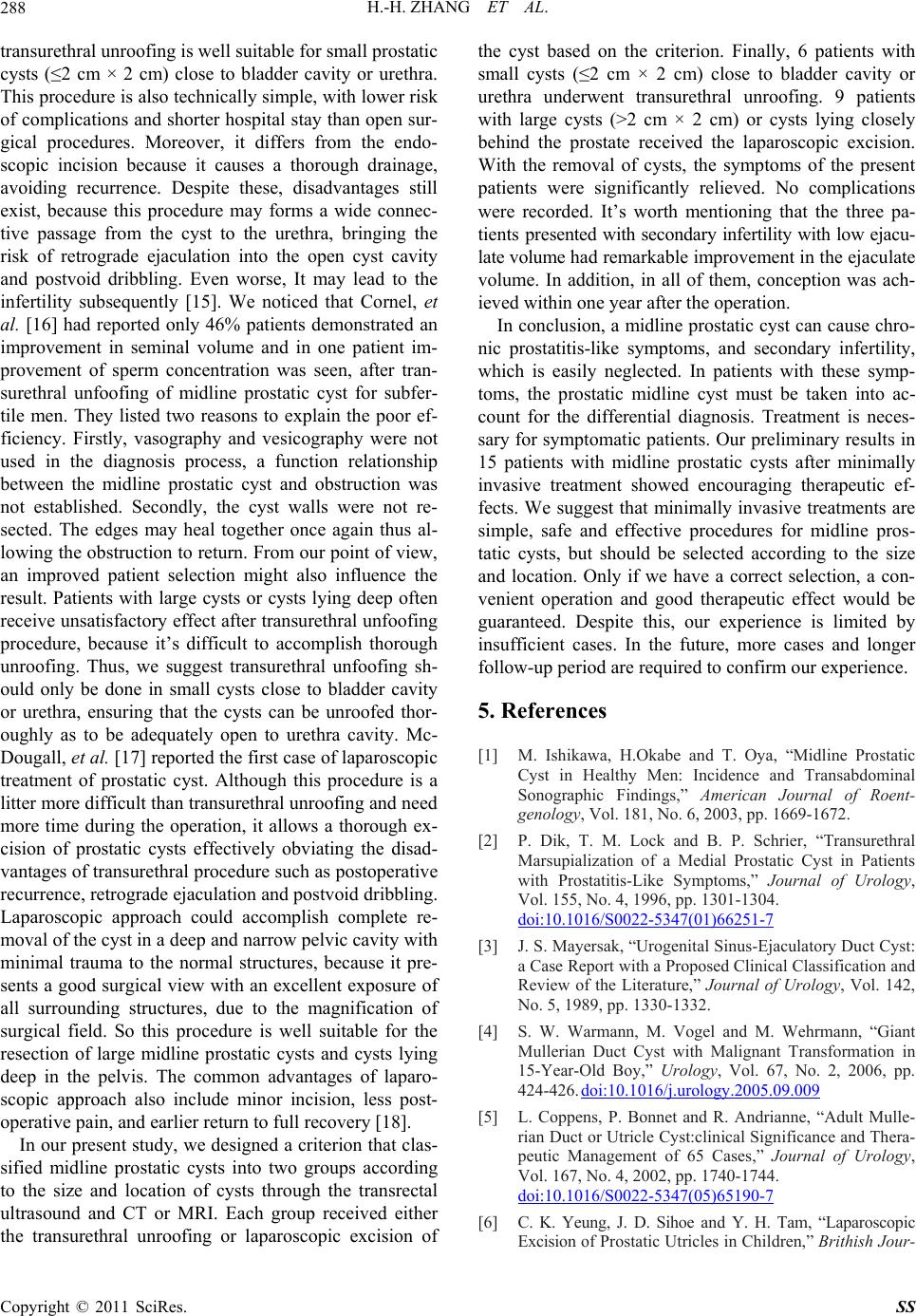
H.-H. ZHANG ET AL.
288
transurethral unroofing is well suitable for small prostatic
cysts (≤2 cm × 2 cm) close to bladder cavity or urethra.
This procedure is also technically simple, with lower risk
of complications and shorter hospital stay than open sur-
gical procedures. Moreover, it differs from the endo-
scopic incision because it causes a thorough drainage,
avoiding recurrence. Despite these, disadvantages still
exist, because this procedure may forms a wide connec-
tive passage from the cyst to the urethra, bringing the
risk of retrograde ejaculation into the open cyst cavity
and postvoid dribbling. Even worse, It may lead to the
infertility subsequently [15]. We noticed that Cornel, et
al. [16] had reported only 46% patients demonstrated an
improvement in seminal volume and in one patient im-
provement of sperm concentration was seen, after tran-
surethral unfoofing of midline prostatic cyst for subfer-
tile men. They listed two reasons to explain the poor ef-
ficiency. Firstly, vasography and vesicography were not
used in the diagnosis process, a function relationship
between the midline prostatic cyst and obstruction was
not established. Secondly, the cyst walls were not re-
sected. The edges may heal together once again thus al-
lowing the obstruction to return. From our point of view,
an improved patient selection might also influence the
result. Patients with large cysts or cysts lying deep often
receive unsatisfactory effect after transurethral unfoofing
procedure, because it’s difficult to accomplish thorough
unroofing. Thus, we suggest transurethral unfoofing sh-
ould only be done in small cysts close to bladder cavity
or urethra, ensuring that the cysts can be unroofed thor-
oughly as to be adequately open to urethra cavity. Mc-
Dougall, et al. [17] reported the first case of laparoscopic
treatment of prostatic cyst. Although this procedure is a
litter more difficult than transurethral unroofing and need
more time during the operation, it allows a thorough ex-
cision of prostatic cysts effectively obviating the disad-
vantages of transurethral procedure such as postoperative
recurrence, retrograde ejaculation and postvoid dribbling.
Laparoscopic approach could accomplish complete re-
moval of the cyst in a deep and narrow pelvic cavity with
minimal trauma to the normal structures, because it pre-
sents a good surgical view with an excellent exposure of
all surrounding structures, due to the magnification of
surgical field. So this procedure is well suitable for the
resection of large midline prostatic cysts and cysts lying
deep in the pelvis. The common advantages of laparo-
scopic approach also include minor incision, less post-
operative pain, and earlier return to full recovery [18].
In our present study, we designed a criterion that clas-
sified midline prostatic cysts into two groups according
to the size and location of cysts through the transrectal
ultrasound and CT or MRI. Each group received either
the transurethral unroofing or laparoscopic excision of
the cyst based on the criterion. Finally, 6 patients with
small cysts (≤2 cm × 2 cm) close to bladder cavity or
urethra underwent transurethral unroofing. 9 patients
with large cysts (>2 cm × 2 cm) or cysts lying closely
behind the prostate received the laparoscopic excision.
With the removal of cysts, the symptoms of the present
patients were significantly relieved. No complications
were recorded. It’s worth mentioning that the three pa-
tients presented with secondary infertility with low ejacu-
late volume had remarkable improvement in the ejaculate
volume. In addition, in all of them, conception was ach-
ieved within one year after the operation.
In conclusion, a midline prostatic cyst can cause chro-
nic prostatitis-like symptoms, and secondary infertility,
which is easily neglected. In patients with these symp-
toms, the prostatic midline cyst must be taken into ac-
count for the differential diagnosis. Treatment is neces-
sary for symptomatic patients. Our preliminary results in
15 patients with midline prostatic cysts after minimally
invasive treatment showed encouraging therapeutic ef-
fects. We suggest that minimally invasive treatments are
simple, safe and effective procedures for midline pros-
tatic cysts, but should be selected according to the size
and location. Only if we have a correct selection, a con-
venient operation and good therapeutic effect would be
guaranteed. Despite this, our experience is limited by
insufficient cases. In the future, more cases and longer
follow-up period are required to confirm our experience.
5. References
[1] M. Ishikawa, H.Okabe and T. Oya, “Midline Prostatic
Cyst in Healthy Men: Incidence and Transabdominal
Sonographic Findings,” American Journal of Roent-
genology, Vol. 181, No. 6, 2003, pp. 1669-1672.
[2] P. Dik, T. M. Lock and B. P. Schrier, “Transurethral
Marsupialization of a Medial Prostatic Cyst in Patients
with Prostatitis-Like Symptoms,” Journal of Urology,
Vol. 155, No. 4, 1996, pp. 1301-1304.
doi:10.1016/S0022-5347(01)66251-7
[3] J. S. Mayersak, “Urogenital Sinus-Ejaculatory Duct Cyst:
a Case Report with a Proposed Clinical Classification and
Review of the Literature,” Journal of Urology, Vol. 142,
No. 5, 1989, pp. 1330-1332.
[4] S. W. Warmann, M. Vogel and M. Wehrmann, “Giant
Mullerian Duct Cyst with Malignant Transformation in
15-Year-Old Boy,” Urology, Vol. 67, No. 2, 2006, pp.
424-426. doi:10.1016/j.urology.2005.09.009
[5] L. Coppens, P. Bonnet and R. Andrianne, “Adult Mulle-
rian Duct or Utricle Cyst:clinical Significance and Thera-
peutic Management of 65 Cases,” Journal of Urology,
Vol. 167, No. 4, 2002, pp. 1740-1744.
doi:10.1016/S0022-5347(05)65190-7
[6] C. K. Yeung, J. D. Sihoe and Y. H. Tam, “Laparoscopic
Excision of Prostatic Utricles in Children,” Brithish Jour-
Copyright © 2011 SciRes. SS